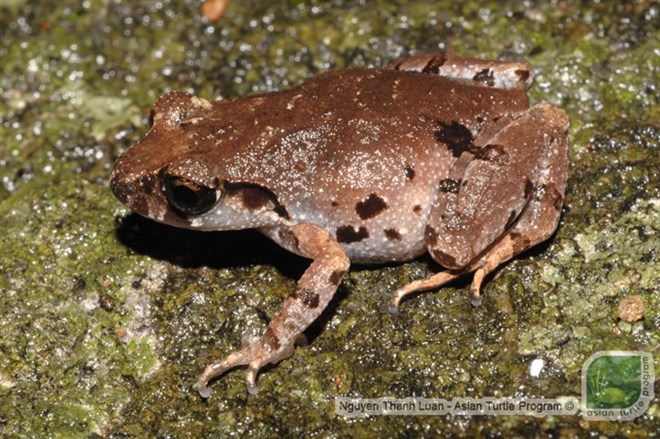
A new amphibian was discovered by a group of scientists and biologists in the Son Tra Nature Reserve in the central city of Da Nang following researches between 2012 and 2018. A scientific report of the new species was released in the scientific magazine Zootaxa – a peer-reviewed scientific mega journal for animal taxonomists, on March 1.
 |
| Rowley’s litter frog (leptolalax rowleyae) is a new amphibian species found in the Son Tra Nature Reserve in Da Nang. |
A new amphibian was discovered by a group of scientists and biologists in the Son Tra Nature Reserve in the central city of Da Nang following researches between 2012 and 2018. A scientific report of the new species was released in the scientific magazine Zootaxa – a peer-reviewed scientific mega journal for animal taxonomists, on March 1.
Nguyen Thanh Luan, scientific officer of the Asian Turtle Programme-Indo-Myanmar Conservation confirmed to Vietnam News on March 1 that the species – Rowley’s litter frog (leptolalax rowleyae) was found by Vietnamese Dr Phan Thi Hoa from Da Nang College for teachers’ training in 2012 when she was completing her thesis on reptile and amphibian species in the Son Tra Nature Reserve.
Luan said Hoa found a population of the frog in the forest 400m above sea level, but the species had not yet been identified.
He said he and Hoa together with Vietnamese scientists and colleagues from Russia and Canada continued research on the species.
Luan, who authored the newly published report in Zootaxa magazine, said the group then identified Rowley’s litter frog as the new species through research and photos.
Researchers said the new frog was named after Dr Rowley Jodi from Australia who spent a long time researching and working on the conservation of amphibian species in Vietnam from 2007.
Luan said the frog measures only 3cm and lives upstream in evergreen forests. The frog can not be easily found in the forest as it often hides deeply in thick layers of dead leaves and its sound was believed to be insects’.
Scientists said the discovery of the new frog showed that the Son Tra Nature Reserve is one of the most bio-diverse areas in Vietnam and needs more research in the near future as well as strict conservation and protection measures.
Luan said the new frog had not yet been classified as endangered, but he warned that human activities and waste discharge in streams in the reserve must be banned.
In 2016, the Southern Institute of Ecology also discovered three new plant species of the ginger family that were unknown to the world.
According to the latest report from the institute, the 4,439ha Son Tra Reserve, 600 metres above sea level, listed 370 animal species and 1,010 plant species.
The reserve, 10km away from Da Nang, has 43 plant species listed as endangered in Vietnam’s Red Book and the International Union for Conservation of Nature (IUCN).
More than 237 herds of the endangered red-shanked douc langurs (Pygathryx nemaeus) with over 1,300 individuals are living in the Son Tra Nature Reserve.
In 2016, IUCN agreed to promote the red-shanked douc langur as a Critically Endangered (CR) species, granting it termless protection status in the world.
The Da Nang-based centre for biodiversity research and conservation, GreenViet, warned that the development of concrete buildings around the reserve, mostly holiday beach resorts, would soon push the endangered primates into extinction.
(Source: VNA)





